#contemporary Puerto Rican art
Explore tagged Tumblr posts
Text

Arnaldo Roche Rabell (Puerto Rican b. 1955), The Tease, 1989. Oil on canvas, 83 x 120 in. | 210.8 x 304.8 cm.
#art#artwork#modern art#contemporary art#modern artwork#contemporary artwork#21st century modern art#21st century contemporary art#Puerto Rican art#modern Puerto Rican art#contemporary Puerto Rican art#Puerto Rican artist#Puerto Rican painter#Arnaldo Roche Rabell#neo expressionism
4 notes
·
View notes
Text
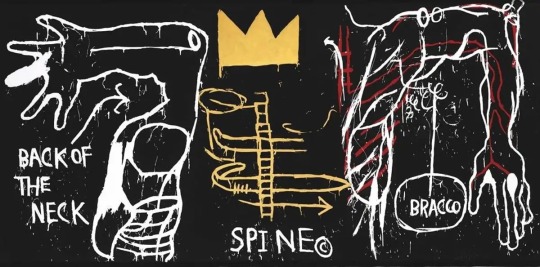
Jean-Michel Basquiat
Back Of The Neck
1983
#jean michel basquiat#basquiat#american painter#american artist#haitian art#haitian artist#puerto rican artist#modern art#contemporary art#art history#aesthetictumblr#tumblraesthetic#american art#tumblrpic#tumblrpictures#tumblr art#tumblrstyle#artists on tumblr#aesthetic#graffiti artist#SAMO#new york city#beautiful#beauty
58 notes
·
View notes
Text

[SOLD] Black Ink Painting by Nicole Noemí
#ink art#abstract#mine#nicole noemi#puerto rican art#artists on tumblr#contemporary art#painting#surrealism
16 notes
·
View notes
Text


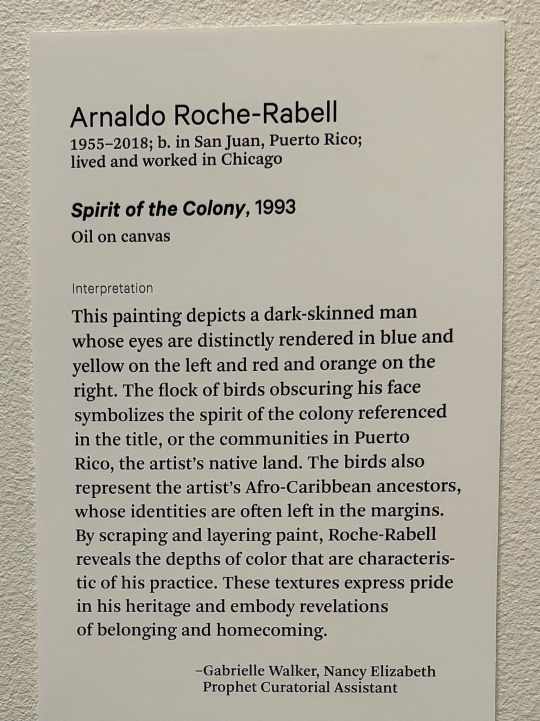
Arnaldo Roche-Rabell (American, b. Puerto Rico, 1955-2018)
Spirit of the Colony, 1993
Oil on canvas, 195.6 x 195.9 cm (77 x 77 1/8 in)
on display at RISD Museum
“This painting depicts a dark-skinned man whose eyes are distinctly rendered in blue and yellow on the left and red and orange on the right. The flock of birds obscuring his face symbolizes the spirit of the colony referenced in the title, or the communities in Puerto Rico, the artist's native land. The birds also represent the artist's Afro-Caribbean ancestors, whose identities are often left in the margins.
By scraping and layering paint, Roche-Rabell reveals the depths of color that are characteristic of his practice. These textures express pride in his heritage and embody revelations of belonging and homecoming.”
#animals in art#20th century art#museum visit#birds in art#bird#birds#Puerto Rican art#American art#Caribbean art#contemporary art#modern art#painting#oil painting#RISD Museum#Arnaldo Roche-Rabel
2 notes
·
View notes
Video
youtube
Exhibit showcases Puerto Rican artists' reaction to Hurricane Maria and its aftermath, January 26, 2023
A response from artists to Hurricane Maria and its aftermath is billed as the first major U.S. Museum exhibition of Puerto Rican art in nearly 50 years. The 2017 disaster inspired some 50 works by 20 Puerto Rican artists based on the island and elsewhere. Jeffrey Brown visited New York’s Whitney Museum for our arts and culture series, CANVAS.
PBS NewsHour
#Puerto Rico#Puerto Rican#art#american#Hurricane Maria#Whitney Museum#exhibition#activism#contemporary#perspective#pbs newshour#colonialism#protest#politics#relevant#austerity#negligence#infrastructure#USA
0 notes
Text
A Business Proposal
A little while ago, I posted an interest poll for a series I'm planning. Since many of you responded that you were at least curious, I come today with... limited information. Limited, because the novel version of this series is currently being read by a literary agent.
But I've always felt that this story was too big to be contained in book format. Under a traditional publisher, I would lose the rights to my own property, so if they didn't want to see more of it, that's that for myself and the characters and the readers who fall in love with the characters. Self-publishing is harder. It needs to be a collaborative effort between writer and readers if it's going to succeed. Thus, I turn to the only audience I have with my "business proposal."
(Note: If you've been around long enough, you might recognize some of these characters from posts that have since been deleted.)
~*~
Working Title: Trainwrecks Length of Series: 8 seasons Length of Seasons: 24 episodes, 12 main and 12 bonus, posted biweekly. (Each season will last three months.) Episode Length: 1000-2000 words Setting: Seattle, Washington and its surrounding towns, between the years 2004-2015 Genre: Contemporary, YA to New Adult
Trainwrecks follows a diverse group of six best friends from high school to their mid-twenties, with all the romance, heartache, college and career decisions, and confusion that entails. Our main cast:
A bubbly, fat Puerto Rican girl with a passion for art and matchmaking (Ages: 14-25)
Her adopted, Argentinian brother, who is adept at music and pretty much nothing else (Ages: 16-27)
Their childhood best friend, an Asian/British/American guy who hides years of trauma behind a flamboyant and overbearing personality (Ages: 19-30)
His ill-tempered younger sister, who has just moved back to the United States from London after their parents divorced fifteen years ago (Ages: 14-25)
An equally bad-tempered Hawaiian/French guy with a love of photography and a hatred of bullies (Ages: 14-25)
The coolest, most beautiful Chinese girl you'll ever meet, who is fighting a sex addiction after a history of abuse (Ages: 16-27)
Main episodes will be written in story format. Bonus episodes will be in epistolary format: MSN chats, text messages, letters, blog posts, and eventually Twitter posts. Y'know, cuz Twitter didn't exist in 2004.
The main series (8 seasons, 24 episodes each) will be completely free to read and delivered directly to your email inbox. There will be character artwork, a bio page to keep track of everyone, a tie-in Tumblr account for memes, Spotify playlists for each character, and helpful things like family trees and relationship charts as well. Each season will have its own key artwork---cover art, if you will.
In addition to the completely free story, there will be extra content for paid subscribers and Patreon patrons, including but not limited to:
Sneak previews/early updates
Side stories
Back stories
Character and universe development notes
Entire AUs with different relationships or different genres
Money raised will either go towards paying artists or towards my student loans. And if the series gets really popular, I intend to launch a Kickstarter for physical copies that will include all the artwork and maybe some bonus items as well.
That's my business proposal. If you like it or have questions, comment on this post, scream in my inbox, chat me---do whatever but do it vocally because I need to know you're out there. And then, feel free to follow my Substack for updates.
34 notes
·
View notes
Text
SPIDER-VERSE On The Brain

Massive SPIDER-VERSE *spoilers* are ahead... Do not read on if you haven't seen the movie...
It's been four days since I checked out SPIDER-MAN: ACROSS THE SPIDER-VERSE in theaters... And I'm still processing such a rich layer cake of a movie with all this stuff going on, just the sheer ambition of it... And... This story isn't even over, that's the mind-blowing part...
This movie did have pretty strong arcs for Miles Morales, Gwen Stacy, and even Peter B. Parker to some extent, in addition to introducing a major conflict and a soon-to-be-primary antagonist in Miguel O'Hara/Spider-Man 2099... While a larger threat, The Spot, still looms, and there's even a closer to home threat for Miles himself as the picture wraps up...
There's so much more to go, assuming that BEYOND THE SPIDER-VERSE is also going to be a pretty long movie. That this movie was, in the planning stages, getting to be so big that they had to break it up into two parts? Who knows what we're in for...
I feel a lot of ACROSS THE SPIDER-VERSE's narrative brilliance is within its yet to be resolved conflict...
Canon...
Back in 2018, INTO THE SPIDER-VERSE came onto the scene with its dynamic new way of rendering CGI imagery in an animated feature, while throwing in eye-candy flourishes and other dynamic art styles to really make that movie pop amongst other mainstream animated movies *and* the entire comic book movie sphere. In a neat sense, this groundbreaking new way to make an animated feature strengthened the inclusive and quite simple overall message of the story: ANYONE can be Spider-Man.
Now, if INTO THE SPIDER-VERSE said "anyone can be Spider-Man", ACROSS THE SPIDER-VERSE asks what that "anyone" must go through to be Spider-Man.
Can Spider-Man truly be anyone?
What is "canon"?
Miguel is adamant that every Spider, from man to woman to animal to insect, must experience some major tragedy in order to truly be a Spider-Something. A loss of a family member, close friend, or any kind of loved one... That's that about that, that's the nature of the "Spider-Verse", it is set in stone, no other way! Seems to contradict "Anyone can be Spider-Man", right? Apparently Miles can't have a relatively normal non-costumed life, someone he loves HAS to be axed... And that's the case with... How many Spiders? Over 280?
... which quite frankly sounds very controlling and lacking in imagination. And kinda dumb on paper. Miles knows that, even... It all relates back to what his mother and father want for him vs. his ambitions and desires.
"Nah, imma do my own thing"...
Such a liberating line, during such a literally and figuratively heavy moment in the film...
Between Miles' arc and Gwen's story, this autistic queer right here felt something quite resonant from all of this... I needed to see and hear these classic story tropes pulled off in such a great new way at a crucial time in my life...
Now, this works even beyond one's personal journey and how a film relates to someone: ACROSS THE SPIDER-VERSE seems cleverly critical of contemporary superhero movie culture and most nerd-dom, from its most toxic swamps to its most boring offices. Adherence to "canon", shackling oneself to hard-set rules that mustn't be deviated from. It's especially potent coming from a movie series where the main Spider-Man is a black/Puerto Rican teenager, and his pals include a trans Spider-Woman, an older adult Peter Parker who has a child, and many more.
The insistence that Spider-Man has to be this one thing, i.e. Miguel running a Spider-Society that makes sure all Spider-People have that very "Uncle Ben" tragedy happen to them, with NO ANOMALIES... Miles' whole existence as Spider-Man, of course, is revealed to be said anomaly... In that a spider from another universe, Earth-42, got to his, Earth-1610, and bit him... Messing everything up... He's even blamed for Earth-1610 Peter Parker's death, to add insult to injury!
Or DID he mess things up?
Maybe "canon" is a bunch of bullshit.
The very kind of thing that shackles whole characters and franchises down, instead of letting those who come to the sandbox play with the toys THEIR way. INTO THE SPIDER-VERSE came to CG animation and didn't do the Pixar style, didn't do what most other mainstream animated movies were doing, didn't follow the accepted "standard" or "canon"... A friend of mine, in his review of ACROSS THE SPIDER-VERSE, noted something very interesting: This also ties into how a lot of very online animation fans insist that every new movie now must be like SPIDER-VERSE. And like PUSS IN BOOTS: THE LAST WISH. And like any other animated movie that they consider "top tier" or "based" or "cinema". Including a relatively-panned Mario movie. Screw off if you're Pixar making "mid" movies like TURNING RED and ELEMENTAL, or Disney Animation making equally "mid" movies like ENCANTO or RAYA AND THE LAST DRAGON... "Canon" in feature animation, apparently, is now movies that must be like SPIDER-VERSE or PUSS IN BOOTS or whatever. Animated movie "requirements". You have to have scary dark villains, you have to have the most amazing unseen animation style ever, you have to do it all THIS WAY...
This whole "canon" nonsense also ties into superhero movies in general, as well. Even comics, like a lot of runs of Spider-Man are apparently doing... especially in a time of the Marvel Cinematic Universe and the DC movie-verse being clamped down by such hard continuity... That has only morphed into a bigger cluster-cuss, post-SPIDER-VERSE.
I remember when watching the LOKI Disney+ series, thinking... This series is trying to explain in FIVE 40-MINUTE EPISODES something INTO THE SPIDER-VERSE effortlessly explained in less than 5 MINUTES... Then you bring in the Doctor Strange follow-ups, all this stuff about "incursions". Incursions this, Sacred Timelines that... Why is this so goddamn convoluted and wracked head-to-toe with all these RULES? Other multiverse stories don't do this, and Marvel's characters span DECADES... And a big criticism of the recent MCU output is that the continuity, the canon... Doesn't allow for the characters to have their own unique stories, told by filmmakers with individual unique visions working within reasonable guidelines. I feel these two movies, along with EVERYTHING EVERYWHERE ALL AT ONCE, show what a multiverse story can still be in this day and age.
And by using Miguel's rule, ACROSS THE SPIDER-VERSE goes right for the jugular bearing its spider-fangs.
Anyone can be Spider-Man, Spider-Man can have ANY life.
May I also add? The Spot... He's not in the movie much, but his arc... Tying this back to the worst of toxic nerd culture. The Spot is shook by being called some villain of the week and everything else that happened to him (like getting conked by the very bagel from the first movie), and instead of using his weird abilities for something good, he's going to go great lengths to prove that he is not some villain of the week. To become a larger scale threat... And for what? To fill a literal hole in himself? What validity and happiness will this bring him? I see something similar in some aspects of nerd culture, where they take being wronged (I'll humorously compare this to being shoved into lockers, circa 1988) at some point in their life, and turning it into their literal villain origin story... Growing up to be the jocks that bullied them, growing up to be the ones making life harder for other people in the community... The very people complaining about how "w0ke" this movie is for having "forced diversity", the very people who also lob that stolen word at harmless things like the LITTLE MERMAID remake and virtually anything "W0ke Disney" puts out these days, the very people who had literal shit-fits over MAD MAX: FURY ROAD, every new STAR WARS movie, GHOSTBUSTERS 2016, SHE-RA AND THE PRINCESSES OF POWER, new MUPPET BABIES, any new STAR TREK media, the list goes on and on... That's The Spot. Funny how some superhero movies, even animated superhero movies, have these villains who feel like they've been wronged and feel like they're entitled to something...
Just more texture to this ludicrously-textured layer cake movie... Yeah, CAKE itself is a big part of the movie, too. Look at that-
All this, amidst a backdrop of hundreds of Spider-People, a surrealistic smorgasbord of visual styles and animation techniques (Spider-Punk alone, YOWZA YOWZA YOWZA!), a multiverse-spanning story, and at the end... All of it tying back to who Miles Morales wants to be. How he wants to tell HIS story... When he defies Miguel on the train, it's a monumental moment...
And the story isn't even over yet... This movie is something special.
#spider man across the spiderverse spoilers#spider man across the spiderverse#spiderverse#across the spiderverse#unorganized thoughts#animated movies#personal thoughts
29 notes
·
View notes
Photo
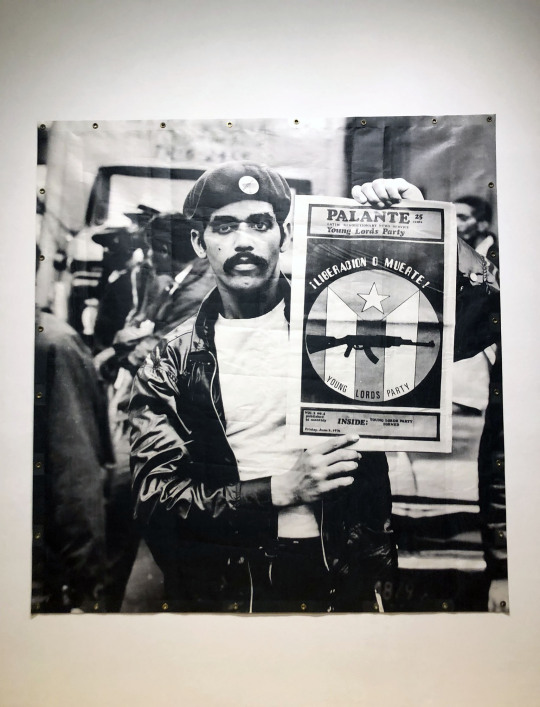
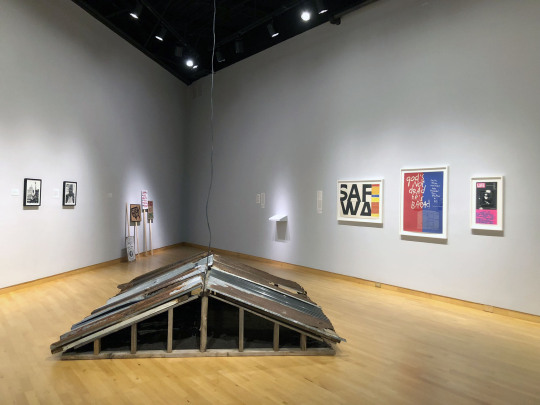
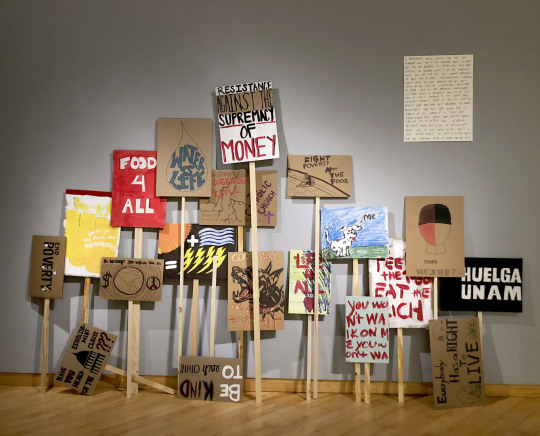
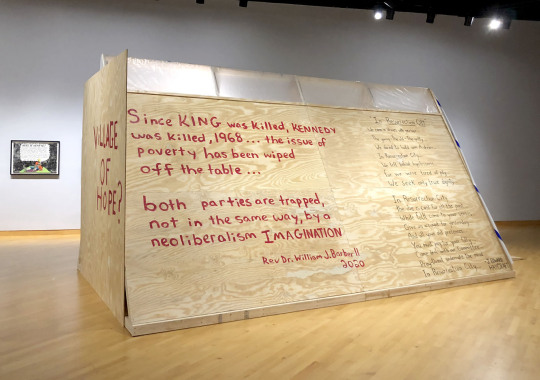

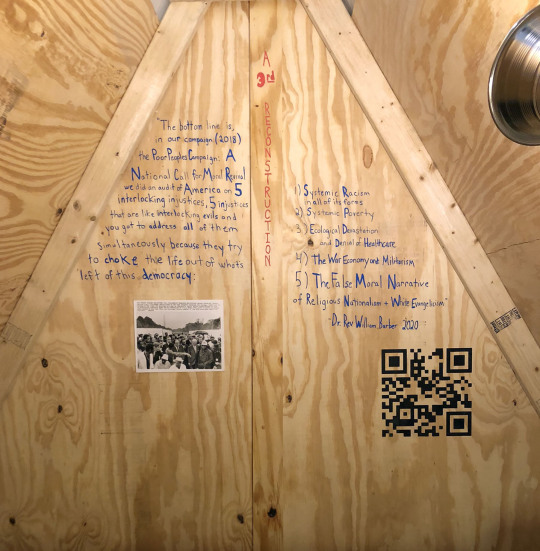
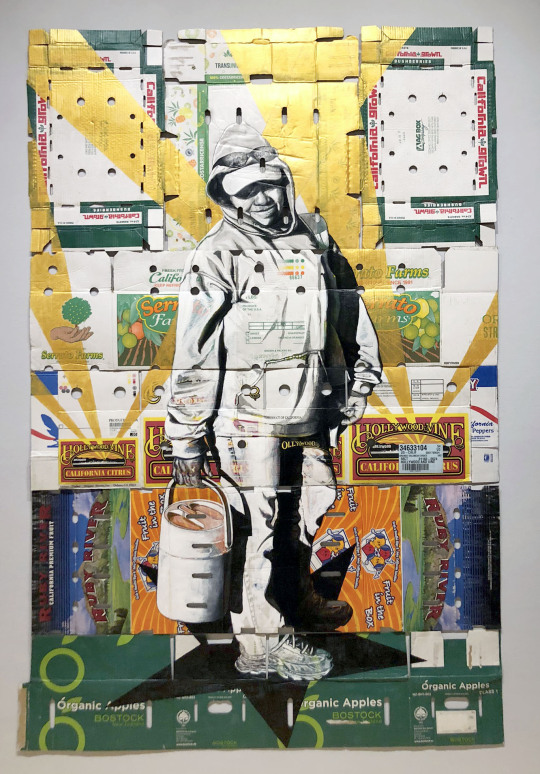


Poor People’s Art: A (Short) Visual History of Poverty in the United States at USF Contemporary Art Museum in Tampa uses installations and artworks to tell the story of, and expand perspectives on, The Poor People’s Campaign- from its origins in the late 1960s to the present day form, as well as comment on poverty and other social issues. Both educational and engaging, it shows that despite long struggles and some progress, we are still very far from much needed social change, especially in regards to poverty.
The museum also produced a free full color, 48 page workbook that you can pick up there or download as a PDF that can be downloaded from their website.
From the gallery’s website-
Dr. Martin Luther King Jr. is well known for his “I Have a Dream” speech, yet much less emphasis is placed on his campaign to seek justice for America’s poor, “The Poor People’s Campaign.” This was a multi-cultural, multi-faith, multi-racial movement aimed at uniting poor people and their allies to demand an end to poverty and inequality. Fifty-three years after Dr. King’s death, the Reverend William Barber II launched a contemporary push to fulfill MLK’s ambitious brief — one that calls for a “revolution of values” that unites poor and impacted communities across the country. The exhibition Poor People’s Art: A (Short) Visual History of Poverty in the United States represents a visual response to Dr. King’s “last great dream” as well as Reverend Barber’s recent “National Call for Moral Revival.”
With artworks spanning more than 50 years, the exhibition is divided into two parts: Resurrection (1968-1994) and Revival (1995-2022). Resurrection includes photographs, paintings, prints, videos, sculptures, books, and ephemera made by a radically inclusive company of American artists, from Jill Freedman’s photographs of Resurrection City, the tent enclave that King’s followers erected on the National Mall in 1968, to John Ahearns’ plaster cast sculpture Luis Fuentes, South Bronx (1979). Revival offers contemporary engagement across a range of approaches, materials, and points of view. Conceived in a declared opposition to poverty, racism, militarism, environmental destruction, health inequities, and other interlocking injustices, this exhibition shows how artists in the US have visualized poverty and its myriad knock-on effects since 1968. Participating artists include John Ahearn, Nina Berman, Martha De la Cruz, Jill Freedman, Rico Gatson, Mark Thomas Gibson, Corita Kent, Jason Lazarus, Miguel Luciano, Hiram Maristany, Narsiso Martinez, Adrian Piper, Robert Rauschenberg, Rodrigo Valenzuela, William Villalongo & Shraddha Ramani, and Marie Watt.
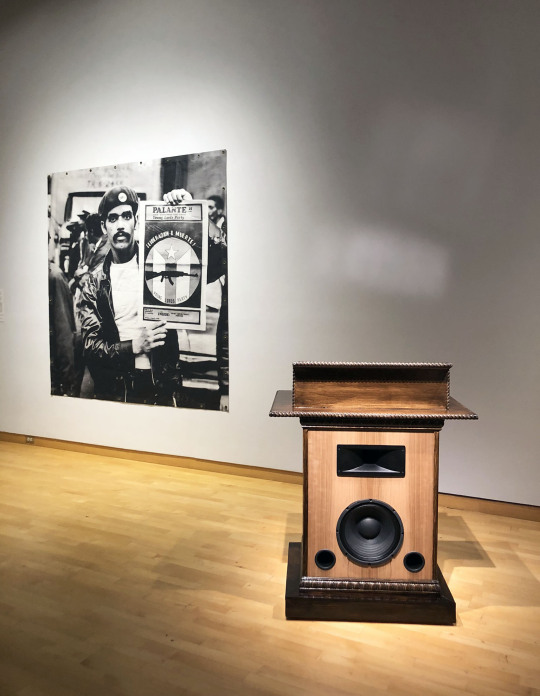
From the museum’s wall plaque about the images from the artists above-
A multimedia visual artist whose work explores themes of history, popular culture, and social justice, Miguel Luciano revisits the history of the Young Lords, a revolutionary group of young Puerto Rican activists who organized for social justice in their communities beginning in the late 1960s. Luciano’s first contribution to Poor People’s Art is a vinyl banner from the public art project Mapping Resistance: The Young Lords in El Barrio (2019), a collaboration with artist Hiram Maristany. It features the photograph “Young Lords Member with Pa’lante Newspaper (1970)” by Maristany, who was the official photographer of the Young Lords and a founding member of the New York chapter. This banner, along with nine other enlarged Maristany photographs, were installed throughout East Harlem at the same locations where their history occurred 50 years prior.
Luciano’s second contribution to Poor People’s Art is the sculpture The People’s Pulpit (2022), a repurposed vintage pulpit from the First Spanish Methodist Church in East Harlem. The Young Lords famously took over the church in 1969 and renamed it “The People’s Church”; they hosted free breakfast programs, clothing drives, health screenings, and other community services there. In this exhibition, The People’s Pulpit features an historic recording of Nuyorican poet Pedro Pietri reciting the celebrated poem Puerto Rican Obituary during the Young Lord’s takeover of The People’s Church.
The central sculpture in the second photo-
Afro-Taino artist Martha De la Cruz fashioned her sculptural installation Techo de sin (Roof of Without), 2021, from stolen, scavenged and donated materials found in Southwest Florida. According to the artist, “Florida is home to a large population of Latin American migrants who have ended up in the US largely due to economic pressures, exploitation and veins of power etched by Europe and the US.” Her powerful work deals with the results of this disjunction and the “symptoms thereabouts (e.g. houselessness, fugitiv-ity, government corruption, and income disparity, etc.).” According to De la Cruz, the word “sin” is a common Dominican mispronunciation for the word “zinc.” The sculpture is animated by a single light bulb that turns on for just ten minutes a day.
From the wall plaque about the Lazarus installation (structure in the 3th, 5th and 6th photos)-
Jason Lazarus’s sculptural installation Resurrection City/Poor People’s Campaign: A National call for Moral Revival/A Third Reconstruction (2023) is anchored in the artist’s historical research and several key photographs of Resurrection City. A tent-like shelter inspired by the temporary residences that populated the 1968 mass protest, the interactive sculpture contains simple sleeping quarters and a curated library filled with physical literature and ephemera centered on both the 1968 Poor People’s Campaign and the 2018 Poor People’s Campaign: A National Call for Moral Revival, co-led by Rev. Dr.William Barber and Rev. Dr. Liz Theoharis.
The library allows for audiences to trace, listen, and talk about the history of advocating for the poor, from 1865 to the present. Additionally, the artist provides a custom transcription (and a QR hyperlink) to Barber’s 49-minute address on the syndicated radio show “The Breakfast Club” in which he carefully outlines his powerful vision for how we might address poverty going forward.

About Jill Freedman’s photograph above-
In the spring of 1968, the talented young street photographer Jill Freedman quit her day job as a copywriter in New York City to join the Poor People’s March on Washington. Freedman lived in Resurrection City for the entire six weeks of the encampment’s existence, photographing its residents as they rallied, made speeches, protested in front of government buildings, confronted police, built makeshift kitchens, organized clothing swaps, and dealt with flooding, petty crime, and illness. One of the most important postwar documentarians, and one of the few women photographers of the era, Freedman captured it all. Freedman’s 2017 book, Resurrection City, 1968-from which this exhibition draws a dozen powerful images-showcases the photographs that she made as a participant in the original Poor People’s Campaign. In multiple ways, Freedman’s images are the sympathetic perch upon much of which much of the present exhibition loosely hangs.
This exhibition closes 3/4/23.
#usf contemporary art museum#tampa art shows#poor people's campaign#poor people's art#miguel luciano#hiram maristany#martha de la cruz#jill freedman#narsiso martinez#jason lazarus#art installation#social issues#art#art shows#poverty#mark thomas gibson#rico gatson#florida art shows#photography#sculpture#drawing
16 notes
·
View notes
Text
Character Intro: Lucia (My Life is a Telenovela!)


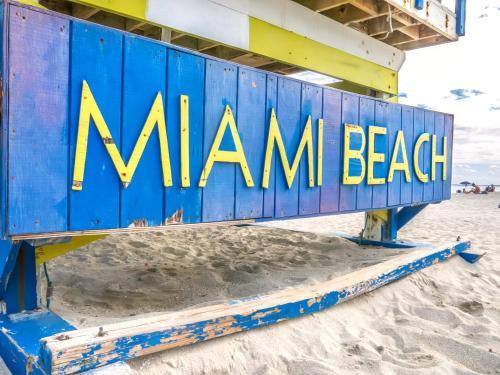








Full name- Lucia Angelina Serratos
Birth date- March 25th
Place of birth- Miami, Florida
Age (in novel)- 17
Favorite color- Peach
Favorite season- Spring (says it’s not boiling hot in Florida)
Favorite food- tostones with salsa verde sauce (loves making them with her abuela)
Favorite ice cream flavor- raspberry lemon
Favorite dessert- almond torte (also likes her abuela’s flan)
Favorite sandwich- chicken cheesesteak
Favorite actor- Ryan Gosling
Favorite actress- Emma Stone
Favorite movie- Mean Girls
Favorite TV shows- Jane the Virgin, Sex Education, Sex and the City, Euphoria, As Told by Ginger, The Wild Thornberrys, Hey Arnold, Moesha
Favorite singers- Jennifer Lopez, Ariana Grande, Lady Gaga, Lana Del Rey, Dua Lipa, Ella Mai, Selena, Bruno Mars, Shakira, Gloria Estafan
Favorite bands- Imagine Dragons, BTS, The Rose, Blackpink, Journey, Paramore, Fall Out Boy
Favorite book- When I Was Puerto Rican by Esmeralda Santiago
She's currently a junior at True Performance School of the Arts. Lucia hopes to be an acclaimed screenwriter someday, maybe also directing as well.
Her mom is Puerto Rican while her dad is Mexican.
Lucia can speak some Spanish, but is also able to follow through an entire conversation.
She has been both to Puerto Rico & Mexico during the summer as a kid. One favorite memory was when she went to a fireworks show in San Juan when she was eight.
Lucia has unofficial acting credits! Her on-screen debut was as the baby being born to her parents' characters on the telenovela Las Pasiones de Mirabel. She was also a covergirl- not exactly, but she & her parents were the cover story in People en Espanol as a birth annoucement!
Through her padrino's connections, Lucia was able to meet a few Latin celebrities including Vibora, an up-and-coming Cuban-American rapper.
Birds of Paradise are her favorite flowers!
Lucia isn't really that close with her mother's side of the family. She's confused as to why her mom & abuela won't talk too much about their family history or certain family members.
She keeps a framed photo of her abuelo (her mother's father) when he was young in her bedroom. He died when her mother was just a few days shy of her quinceañera.
Lucia has been on the set of too many telenovelas to count! She has also been her parents' date to the Paloma Awards, an annual event that awards the best telenovela actors & actresses.
She has been best friends with Leonie and America since they were all eight years old, where they all went to the same Sunday school. Lucia became friends with Remy during her freshman year of high school.
At her quinceañera, Marc Anthony performed while Leonie & America were part of her court.
Lucia is really close to her abuela. They go out shopping and they also knit, gossip, & watch telenovelas together. Her favorite activity that she likes doing with her abuela is when they make tostones and arepas!
One favorite pastime of Lucia's is reading. Sure she loves the sweet & fluffy YA contemporaries and romances that litter the back of her closet, but she also doesn't mind delving into the magical realism of latin writing greats like Isabel Allende, Gabriel García Márquez, and Julia Alvarez.
She had her first kiss when she was nine at her Communion party with a boy named Joel.
Lucia's first real relationship was with a guy named Chris Del Toro during her sophmore year. They dated for about six months before he & his family moved to Washington State.
She has a secret tattoo- a small pair of dove wings expertly hidden by her right ear. Lucia got it done a couple months ago along with Remy and America, who also got secret tattoos.
At the beginning of junior year, Lucia began crushing on Michael Bernardi, an aspiring photographer! Aside from a few smiles & brief interactions, they've never had an actual conversation.
As a baby, Lucia recieved a gold & diamond necklace with a dove charm by her father. She now almost always wears it!
She has a part time job at Sunshine Swirl, a frozen yogurt shop. The shop is in America's neighborhood, so her place is the first stop for Lucia before she goes home.
Her and her friends love the movie Mean Girls so much that they're all dedicated to wear pink on wednesdays every week till graduation!
#my oc#original character#my original oc#my oc character#my character#oc character#oc intro#character intro#oc introduction#character introduction
5 notes
·
View notes
Text
Photography Research Post 4
As part of a revolutionary American artist, Jean-Michel Basquiat worked profoundly in contemporary art, infusing street culture with high art and re-defining the borders within which such art was possible. He is the Brooklyn-born son of a Haitian father and Puerto Rican mother-with a birth in 1960-and had a life that thus influenced his work for the rest of his lifetime. Initial fame came from graffiti as SAMO, but the late '70s changed to canvas and public recognition almost immediately again New York. Basquiat distinguished himself by raw energy, a lively palette, and a frankness toward expression, all when conceptual art dominated.
Basquiat's art features a spontaneous thrower, somewhat rushes and chaotic, abstraction and imagery grounded mostly in his life experiences. Pieces have references to text with symbols or even figures in them that culminate in layers of meanings that take the audience into considering the race, identity, and political pressure issues. His well-known crown, frequently crowns heads in his paintings, ranges from a totally regal theme to how one would define claiming authority and propriety. It is his example of skeletal figures, references to anatomy, and bright symbols-he seems, as well, constantly busy with issues of the body and human fragility.
It was in the early 1980s that Basquiat's career erupted, and by 1983 he was among the foremost, most celebrated artists of the world. Its exhibitions ranging from the Whitney Museum of American Art in New York to later retrospectives at the Guggenheim Museum and Fondation Louis Vuitton sealed his legacy in the art book. Such works as "Untitled" (1981) and "Hollywood Africans" (1983) are not just consumed, but agonize with reflections over racial inequity and celebrity as well as violence.
Not that I have any great love for Basquiat's art, but I cannot deny the powerful cultural implications which lie behind it. From writing graffiti as a means of expression to becoming one of the sensations in the gallery scene, Basquiat could easily be placed in the category of such artists who could create a humble bridge between the worlds of urban expression and high, traditional fine artistry.
His work replicates his own personal ordeal as a Black artist in America, dealing issues such as race inequality, identity, and societal power. The boldness of the fragmented figures, symbols, and text in his canvases is a kind of immediate rawness and urgency. For example, the crown is motivated by a desire for acknowledgment and authority, especially within a context of black identity and other marginal voices.
While I may not personally identify with the aesthetic of his chaotic, sometimes unsettling canvases, I feel confident in declaring that it has resonated deeply with concerns of race and power while providing a platform for voice usually shunted aside. His paintings speak with raw energy and urgency; they are made bold with disjointed figures, symbols, and text.
Basquiat's significance extends beyond his art style; his very persona became the voice of rage, complexity, and contradictions within the Black experience in America. Even if it isn't my kind of style, I understand it well enough to know why it still has that status in the public and is hailed for breaking barriers at the art and social level.


Refrences https://en.wikipedia.org/wiki/Jean-Michel_Basquiat https://americansuburbx.com/2013/10/jean-michel-basquiat-art-disempowerment-2000.html https://basquiat.com/
0 notes
Text

Jean-Michel Basquiat
Untitled
1981
#jean michel basquiat#basquiat#american artist#american painter#samo#new york#puerto rican artist#haitian art#contemporary art#modern art#art history#aesthetictumblr#tumblraesthetic#american art#tumblrpic#tumblrpictures#tumblr art#tumblrstyle#aesthetic#artists on tumblr#tumblrposts#beauty#beautiful
9 notes
·
View notes
Text
Sparkle and Shine: Discovering Jewelry Stores in Puerto Rico

When you think of Puerto Rico, visions of sandy beaches and colorful streets might come to mind. But did you know that this vibrant island also boasts a rich selection of jewelry stores? Whether you’re looking for a special gift or a unique piece to treat yourself, Puerto Rico's jewelry scene has something for everyone.
Why Shop Local Jewelry in Puerto Rico?
Shopping local has its perks. When you visit jewelry stores in Puerto Rico, you get a taste of the island’s culture. Many stores feature pieces inspired by Puerto Rican heritage and craftsmanship. You’re not just buying a piece of jewelry; you’re taking home a story that resonates with the island's spirit.
Stunning Selections: What to Expect
Puerto Rico's jewelry stores offer a wide range of styles and designs. From elegant gold and silver pieces to intricate beadwork and colorful gemstones, there's truly something for every taste. Many artisans focus on handmade items, adding an extra touch of uniqueness to each piece. You’ll find everything from simple everyday wear to luxurious statement pieces that will make heads turn.
Noteworthy Jewelry Stores to Visit
1. Coastal Charm Co.
One standout option is Coastal Charm Co. This store features a collection that celebrates the beautiful coastline of Puerto Rico. Here, you’ll find pieces that reflect the ocean’s colors and textures, perfect for anyone who loves the beach. The designs are fresh and modern, making it a hotspot for locals and tourists alike.
2. La Casa del Oro
If you're in the market for high-quality gold jewelry, La Casa del Oro is a must-visit. This store is renowned for its stunning gold creations, from classic designs to contemporary styles. The staff is friendly and knowledgeable, ensuring you find exactly what you’re looking for.
3. Joyería D’Leon
Joyería D’Leon is another gem in Puerto Rico’s jewelry scene. This shop specializes in unique, handcrafted pieces that showcase local artisans. The variety here is impressive, and you’ll leave with a one-of-a-kind treasure that supports local talent.
The Perfect Gift for Any Occasion
Searching for the perfect gift? Jewelry stores in Puerto Rico have you covered. Whether you're celebrating a birthday, anniversary, or just want to say "I love you," jewelry makes a timeless gift. From delicate necklaces to bold statement rings, you can find something that perfectly expresses your feelings.
Experience the Art of Jewelry Shopping
Visiting jewelry stores in Puerto Rico isn’t just about shopping; it's an experience. The atmosphere is often warm and inviting, making it a delightful outing. You can chat with the shop owners, learn about the local craft, and even get custom pieces designed just for you. It’s like finding a treasure trove of creativity waiting just for your exploration.
Conclusion: Shine Bright with Puerto Rican Jewelry
Puerto Rico’s Jewelry Stores Puerto Rico more than just shiny pieces. They provide a glimpse into the island's culture and artistry. Whether you’re searching for a special gift or a unique addition to your collection, you'll find treasures that reflect the island's beauty and spirit. So why wait? Dive into the vibrant world of Puerto Rican jewelry and find that perfect piece that speaks to you!
0 notes
Text


Sophie Rivera, Untitled, 1978, printed 2006, gelatin silver print, sheet and image: 48 x 48 in. (121.9 x 121.9 cm), Smithsonian American Art Museum, Museum purchase through the Luisita L. and Franz H. Denghausen Endowment, 2011.24.1, © 1978, Sophie Rivera
#bornonthisday Sophie Rivera (June 17, 1938 – May 22, 2021) was an American artist and photographer of Puerto Rican-American descent.She was also an early member and instructor of En Foco, a not-for-profit organisation centred on contemporary fine art and photographers of diverse cultures. Rivera is best known for her 1978 photography series Nuyorican Portraits.[3] Redefining Puerto Rican identity in the United States, the series included 50 black and white portraits taken in her home of Puerto Ricans in her neighbourhood. Via Wikipedia
Read: Her portraits of fellow Puerto Rican New Yorkers could be both majestic and tender. She was also a constant street photographer and later made herself her subject.
nytimes.com/2021/06/04/arts/sophie-rivera-dead.html
2. Self portrait in 1978. She was part of a group of photographers, mostly men, who documented New York City’s Puerto Rican community.
#SophieRivera #selfportrait #photographers #NewYorkCity #PuertoRicancommunity #womenphotographers #photography #artherstory #artbywomen #womensart #palianshow #art #womenartists #femaleartist #artist
0 notes
Text
Jean-Michel Basquiat is a Beacon in the East Village Art Scene
In the dimly lit alleys and bohemian lofts of New York City’s East Village, a vibrant art revolution was brewing in the late 1970s. At its forefront stood a young prodigy, Jean-Michel Basquiat, whose meteoric rise to fame would leave an indelible mark on the art world. His raw talent, coupled with an unyielding spirit of creativity, propelled him from obscurity to prominence, earning him a place among the most celebrated artists of the 20th century.
Born in Brooklyn in 1960, Jean-Michel Basquiat journey to artistic acclaim was as unconventional as his work itself. Raised in a melting pot of cultures and influences, he soaked up the dynamic energy of the city streets, which would later become the canvas for his bold expressions. With a father of Haitian descent and a Puerto Rican mother, Basquiat’s heritage infused his art with a rich tapestry of symbolism and identity.
In the late 1970s, the East Village emerged as a hotbed of artistic experimentation, attracting a diverse community of avant-garde creators seeking refuge from the commercialized art world. Basquiat found his sanctuary amidst this eclectic milieu, where he honed his craft alongside fellow visionaries such as Keith Haring and Jean-Michel’s close friend and collaborator, Andy Warhol.
Basquiat’s art defied categorization, blending elements of street graffiti, neo-expressionism, and primitive art into a singular, visceral style. His canvases pulsated with frenetic energy, adorned with enigmatic symbols, cryptic texts, and fragmented figures that spoke to the chaos of urban life and the complexities of the human condition. Each brushstroke seemed to echo the rhythm of the city, capturing its raw vitality and relentless pace.
It was not long before Basquiat’s work caught the attention of the art world’s elite. His first solo exhibition in 1981 at the Annina Nosei Gallery catapulted him into the spotlight, garnering widespread acclaim for his provocative compositions and fearless approach. Critics hailed him as a visionary, while collectors clamored to acquire his pieces, propelling Basquiat from struggling artist to cultural icon virtually overnight.
Central to Basquiat’s appeal was his ability to bridge the gap between high and low culture, drawing inspiration from sources as diverse as jazz, street art, African masks, and classical mythology. His paintings spoke to the universal human experience, transcending boundaries of race, class, and gender to resonate with audiences around the world. In a society marked by division and discord, Basquiat’s art served as a unifying force, offering glimpses of beauty and truth amidst the chaos.
Despite his meteoric rise, Basquiat remained fiercely independent, resisting attempts to commodify or co-opt his work for commercial gain. He rejected the trappings of fame, preferring to immerse himself in the creative process rather than bask in the limelight. His dedication to authenticity and integrity earned him the respect of his peers and secured his legacy as a true pioneer of contemporary art.
Tragically, Basquiat’s life was cut short at the age of 27, succumbing to a heroin overdose in 1988. Yet, his influence endures, his legacy immortalized in the timeless brilliance of his art. Today, Basquiat’s paintings command record prices at auction houses, his name synonymous with innovation and rebellion in the annals of art history.
In the decades since his passing, Basquiat’s impact on the East Village art scene and beyond has only deepened, inspiring successive generations of artists to push the boundaries of creativity and challenge the status quo. His spirit lives on in the vibrant streets of New York City, where his presence is felt in every splash of color, every scrawl of graffiti, and every beat of the city’s pulse. Jean-Michel Basquiat may have risen swiftly to fame, but his legacy will endure for generations to come, a testament to the enduring power of art to shape our world and ignite our imagination.
[Related site1] [Related site2]
0 notes
Link
1 note
·
View note
Text
This is Me..Now Musical Review

After watching Jennifer Lopez's musical production twice, I found myself struggling to grasp the storyline. While the visual aspects were impressive, the narrative felt disjointed and lacked coherence. Audience reception of musicals can vary significantly, and unfortunately, this production missed the mark by a wide margin. The storyline seemed scattered, initially suggesting an exploration of themes such as self-love, yet the inclusion of the story about Alidia and Tyroon at the outset left me uncertain of its overarching message. Watching this musical, I had more questions than answers and felt even more disconnected from the characters than I typically do when watching a movie. So, I'm going to try my hardest to dissect this musical. In the end, I'll provide my final rating for this production.
Act 1- The opening song, "Hearts and Flowers," introduces us to the story of Alidia and Tyroon, two star-crossed lovers from a Puerto Rican fairy tale story that inspired Jennifer as a child. However, the transition from this fairytale to Jennifer on a motorcycle with her presumed current love interest is abrupt and confusing. The narrative further jumps between scenes, showing glimpses of Jennifer in the hospital, then back to the factory, and finally into a therapy session, adding to the disorientation.

The song "Rebound" also feels disconnected, as the message about being involved with someone else while in a relationship is not effectively conveyed through the accompanying dance sequences. The inclusion of domestic violence and sexual interaction in the choreography seems out of place and distracts from the song's message.

The appearance of Zodiac signs as guardian angels is unclear and feels disconnected from the theme of love. The wedding scene and intervention feel forced and unconvincing, especially considering the friends' previous negative discussions about Jennifer's marriages.

Act 2- The therapy session and Love Addicts Anonymous scene come across as insincere and cringeworthy. The dance sequences, particularly the Love Addicts Anonymous routine, feel uncomfortable and forced, lacking the emotional depth expected in contemporary dance.

Act 3- The transition from a heartfelt moment with Little Jenny to Jennifer singing "This is Me...Now" and dancing around the Bronx and the heart factory is jarring. The final two dance sequences feel lackluster and fail to convey the intended emotions of what it is suppose to be finding self-love. The ending, with Jennifer dancing to "Hummingbird," falls flat and does not provide a satisfying conclusion to the musical.

Overall, Jennifer Lopez's attempt to create a visual album akin to Beyonce's "Lemonade" falls short. The storyline is not cohesive, and the message or emotion she was trying to convey is unclear. While she has the right to express her art, the execution of "This is Me...Now" does not live up to the standards set by previous visual albums. Beyonce's "Lemonade" felt like a groundbreaking experience, while J.Lo's "This is Me...Now" feels like a knockoff that lacks the same impact.
Rating: 1.5 Stars
#thisismenow#jlo#newmusic#musicals#new album#album review#music review#jennifer lopez#latina#celebrity
1 note
·
View note